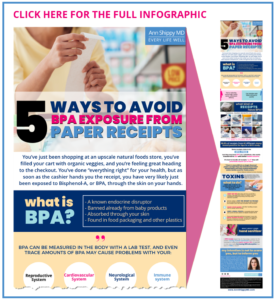You’ve just been shopping at an upscale natural foods store, you’ve filled your cart with organic veggies, and you’re feeling great heading to the checkout. You’ve done “everything right” for your health, but as soon as the cashier hands you the receipt, you have very likely just been exposed to Bisphenol-A, or BPA, through the skin on your hands.
Are Receipts Toxic?
Measurable levels of BPA are found on thermal paper used for credit card machines, ATMs, airline boarding passes, movie tickets, prescription labels, supermarket food labels, and cash registers. A 2015 study tested 170 receipts from 62 different vendors including supermarkets, restaurants, gas stations, and banks, and 168 of them tested positive for BPA.
BPA is a known endocrine disruptor, also found in food packaging and other plastics. It has already been found harmful and banned from use in baby bottles and sippy cups. Much of the latest research is looking into exposure via our diets, but a 2017 study has proven that handling BPA-laden paper leads to increased, measurable levels in the body.
Naysayers deny that there is a problem with receipts, claiming that BPA is “safe” at certain levels and that the amount of exposure received by handling a receipt is negligible. But Dr. John Warner of the Warner Babcock Institute for Green Chemistry says,
“There’s more BPA in a single thermal paper receipt than the total amount that would leach out from a polycarbonate water bottle used for many years.”
And, as I say daily to my patients, “Toxins are cumulative.” Even if the amount of exposure to a toxin is small, these exposures accumulate in the body over time and add up to bigger consequences. BPA is one of the toxins I am able to measure in my patients’ lab tests. Even trace amounts of BPA may cause problems with the reproductive, cardiovascular, neurological and immune systems. In men, it can interfere with libido and sperm quality, and in women, it has been tied to infertility, miscarriage, breast cancer, and even premature delivery.
How to Tell If a Receipt Has BPA
Thermal paper printing is the determining factor. You will know the printout is thermal if you scratch the printed side of the paper and see a dark mark.
Some receipts may claim to be “BPA-free,” but as a substitute, manufacturers often use a different chemical coating called BPS, which is also easily transferred to skin and may have similar health hazards. Without knowing for sure, it’s best to handle all receipts “as if” they will potentially expose you to harm.
How to Avoid BPA in Receipt Tape
Here are five ways to avoid exposure to BPA (or BPS) in paper receipts:
- Just say no when they ask if you would like a receipt, or go paperless if that is an option. If you don’t foresee the need to return anything or have any accounting need for the receipt to be saved, declining it is the easiest way to avoid exposure. Many places offer emailed receipts now as an option. If you need a boarding pass or movie ticket, use your smartphone instead of printing, and shop online whenever possible.
- Ask the cashier to put the receipt in the bag. It’s not a perfect solution, as you’ll still need to handle the receipt later and it may rub off on your food or other belongings. But you will be able to handle the receipt in your own way at another time and place. Avoid placing receipts in bags with raw produce or other unwrapped items.
- Wash your hands well after handling receipts and, as always, before eating.
- Keep a small pouch or resealable plastic bag in your purse and ask cashiers to deposit receipts into it. You are still able to gather and keep receipts, but you don’t need to touch the receipt to collect it. Keeping the receipts together and enclosed also avoids the BPA rubbing off on other purse items you will also be touching.
- If you work frequently with thermal paper in your job, wear nitrile gloves to reduce your exposure. Ask your company to consider changing to a different system for receipts that has non-thermal paper or offers customers paperless options.
What About Using Hand Sanitizer for BPA Receipts?
You might think that cleaning your hands with hand sanitizer would be a good way to stay on top of this problem while you are out for a day of errands. However, a 2014 study found that using hand sanitizer “opens up your skin to allow BPA to get right in,” in the words of Laura Vandenberg, an endocrine disruptor researcher at the University of Massachusetts-Amherst. In fact, hand sanitizer use before handling a receipt could increase the BPA absorption by a factor of 100 or more. Having lotions, sunscreens, or other moisturizers on your hands also can have the same effect.
My intention is not to scare you, but to inform you. We are exposed constantly to toxins of many types– some are in our control, some not. Instead of being overwhelmed by it all, do what you can for things you are able to control, like not handling receipts or buying organic. And work on detoxification daily to address the things you cannot control. Tell others, educate your family, and do what you can to change things in your workplace and schools. Stay connected with me on social media and tell me how it’s going!
Click here to see the detoxifying supplements I recommend to my patients, such as Liposomal Glutathione. You may also wish to see my video on “The Wrong Way to Wash Your Hands,” and my accompanying article about Triclosan, another endocrine disruptor, by clicking here.















